Weed Buyer's Guide
Here's the what's what of purchasing pot, from the packaging and fragrance to the final head test.

Smoking good weed is like having good sex. If you want to be more sensual, employ more of your senses. Likewise with the evil weed-you must see, smell, touch and taste, even listen (not to the marijuana—but to the dude who's trying to sell it to you)—in order to obtain the best quality.
The first thing you must be aware of in your search for quality is the nature of the market at the time. Like any other, the marijuana market has its highs and lows. As we all know from high school economics, when a market is depressed and the demand is high, the prices rise. This is basic principle of supply and demand or as Robert Klein so keenly puts it: "We have all the supply, so we can demand whatever the fuck we want to.” Great or even good products become scarce and the prices become ridiculous. Even mediocre weed costs.
How does one bypass this? How do we insure our heads and the heads of our friends? Do we buy lots of mediocre pot?
Important Pot Principles

Image via Tumblr
To answer these questions we must discuss a few short principles. The first of these is called the quality vs price principle. The other is the concept of the absolute scale of quality. These principles, once mastered and applied, have kept my associates and me in quality weed for many years.
The concept of quality vs price is easily explained, yet, at times, difficult to apply. The explanation goes like this: Price is determined, in general, by the market, while quality of weed is determined, in general, by the smoker.
The factor of price may make one weed more attractive than the other. A fine analogy to illustrate this point would be cars. If someone were to offer you a free car, a Rolls or a Chevy, you would probably pick the Rolls. However, if the same person asked you if you would rather pay for a Rolls or a Chevy, you would probably would take the Chevy.
The other principle deals with the process of grading the quality of each different weed. My colleagues and I have all gradually come to use the 1-to-10 scale system, or the 10-point Wrecked-tor Scale, as it is known to the scientific world.
The reason we came to it gradually is unbelievably simple. We have all gone to cop from some friend and have him wholeheartedly state that it was "great shit." But as you smoke it, you wholeheartedly state it's only "good shit”-not "great shit.” What's the difference between good shit, great shit, dynamite shit, good smoke, out-of-sight smoke and real, fine pot?
Instead of getting lost in bullshit terminology, we rate or grade a sample on the 1-to-10 scale. Let's say I score a pound of smoke and tell my associates that it is a 7.5. They may feel it's an 8.0 or even a 7.0. This, however, is a much more viable assessment than can be obtained playing with words and heads.
Once the principles of the 1-to-10 scale, and quality vs price are learned, the next thing to discuss in a weed buyer's guide is the actual characteristics of the grass itself. But first a little pot anatomy.
A Lesson in Marijuana Anatomy
We must first explain the difference between male plants, female plants and sinsemilla. The male plant, thought to be valueless in the past, is much less potent than the female. It is thinner and less leafy then the female and, therefore, yields less smokable weed. The female plant is bushier.
Sinsemilla is the over natured female plant which has been specially cultivated in isolation so as not to be fertilized by male pollen. It is seedless and super potent. (Sometimes, though rarely, there are seeds which are white and totally infertile).
The reasons for these differences are as follows: First, the potency of the pot is determined by the THC content.
The female pot plant contains vastly more THC than does the male. The female plant, when nearing maturation (4-5 months), begins to send lots of THC up to the flowering buds and tops in order to protect them from several natural enemies. This THC protects the buds from the harsh rays of the sun. In addition, the THC in the seed husks ward off maraudering birds who are extremely fond of pot seed, but not of the THC in the covering husks themselves. The longer the female goes unfertilized, the more potent it becomes. The plant practically goes whacky producing THC.
This brings us to the anatomy of our specific plant. For all intents and purposes, the most potent part of the plant is the top. These buds or tops are the creme de la creme. With most conventional pot (not sinsemilla) the buds contain the crusty seed pods and smaller leaves of the bud itself. These usually appear to be shiny and crusty in appearance, sometimes iridescent. This look of iridescence and crustiness is created by the combination of sticky pollen and THC content in the buds.
The next potent parts are the bushy sections of the plant which contain the clusters of leaves (pseudo buds), and the leaves themselves. This is not to say that the leaves and leaf clusters are of a poor quality, but they are generally of a lesser quality than the buds. The stems and seeds are, of course, of no smoking value.
With that anatomy lesson in mind, our next concern is the physical appearance of the pot as it is sold.
Packing

Image via Tumblr
Some people prefer pot which is compressed into bricks. This is because there is more weight for smaller mass, and over time the pot towards the center of the brick tends to stay fresher than the outer sections, in much the same way as some cheeses.
On the other hand, some people prefer pot which is loosely packed. They state that there is less damage to the buds (and, of course, it looks like you're getting more for your money).
When speaking of the physical appearance of pot, bricked, loosely packed, or simply loose, we should be concerned with the proportions of one segment to another. For example, the proportion of seed to bud may appear to be out whack. This is a frequent guise used to add weight. Another factor to watch is the amount of "shake." Shake refers to weed which has been crumbled or crushed, a result of bricking or over handling (mauling). One should always check for shake. The less the better. This also goes for seeds and twigs.
Color

Image via Tumblr
One of the most widely utilized characteristics for judging the quality of marijuana is its color. It's generally a good indication of quality, yet not an absolute one. Starting from the least potent and ending with the most potent, a general color-quality assessment is: green, brown, black, gold, red. There might be a slight difference of opinion, however. At that point it becomes a matter of personal taste. The proportion of one color to another is also an important thing to look at since pot is very rarely 100 percent one color.
Remember that color is not an absolute indicator. We have seen Thai, green as a hedge, that was at least an 8.0 (more like a 8.5-9.0), and green Mexican Guerrero buds with red highlights that were also high on the 10 point scale. So remember, color is an indicator of quality that is only to be used in conjunction with all other testing procedures in order to determine quality.
A more positive indicator than the specific color is whether the colors appear to be crusty and if there are iridescence hairs on the buds and seed clusters. Red and Gold Colombian are famous for this and Gold Thai usually has this same appearance. Even the finest Mexican buds (Oaxacan or Michoacan) appear to have red or gold iridescent seed covers in contrast to their overall lime green look.
Fragrance

Image via Tumblr
Fragrance is also a fine indicator of the quality of a certain product. This is especially true if this smell carries over to the weed's actual taste.
Possibly the least attractive fragrance is that of weed which has an ammoniated smell. This has been employed in order to disguise the smell of the product from prying canine noses. Another unpopular taste and fragrance for weed is that new mown lawn smell that any Mexican or domestic pot might have. One step above this would be the earthy or musty taste that is frequently associated with Jamaican and some commercial Colombian weed. The next step up would be a sweet smelling weed, perhaps the famed Panama Red or Gold Colombian. The top of the pyramid is a spicy fragrance. This is often associated with the golds and reds of Colombian, sinsemilla, Hawaiian, Thai and even some rare primo Oaxacan.
Texture

Image via Tumblr
A few words at this point on the texture, or feel, of the pot. When you test pot, you should crush the weed between your fingers to feel its texture. The more tacky or sticky it is, the better the quality. If the pot crumbles to dust or seems dry, it is either too dried or perhaps even stale.
Tasting, Testing, and Head Testing

Image via Tumblr
The most important thing to know when tasting grass is that quality is a personal preference. It is an assessment that could, and very well might be, slightly off. Know whom you buy from. You know how they feel about quality relative to your own rating. What is great to one person, might be just fair to another.
Try to utilize that 10-point scale with your tasting and testing, as well as with your circle of heads. It will prove to be well worth the initial hassles. Rate the weed overall for quality. Compare this assessment with the quality vs price rating.
When tasting, it is important to adhere to a few rules of thumb. If you don't, you might just find yourself waking up to a cruel reality. Don't taste when stoned. This point cannot be over emphasized. Clean and roll the joint or blunt yourself. I strongly recommend using one paper per smoke sesh ordinarily, When tasting it's a must. You want to taste the full flavor of the herb, and not the paper. Smoke one joint. Always try to make the assessment according to that one joint. Consider all of the principles which determine the quality of a weed which you will buy and eventually smoke.
And always remember, that whenever possible bring a friend along to compare ratings. For it is known both far and wide that "two heads are better than one.”
About the Creator
Hydro Wilson
Of Alpha Kappa Nu fame. Grew up in Boulder, Colorado. Addicted to Halo.






Comments
There are no comments for this story
Be the first to respond and start the conversation.